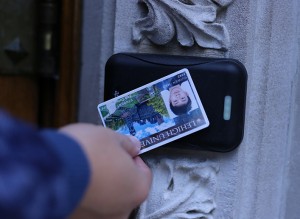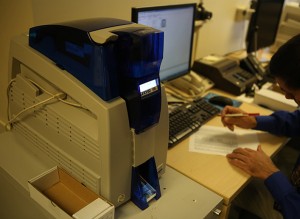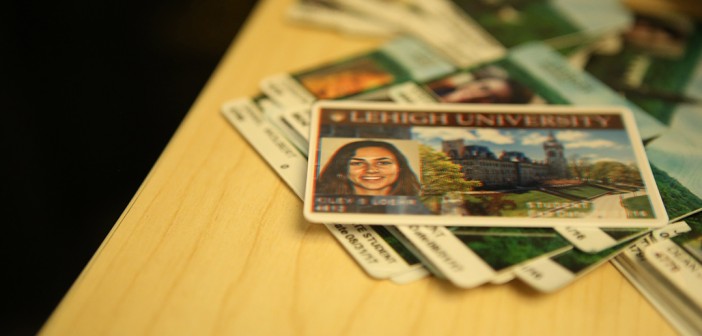
Huiwen Mao, ’16, swipes outside Packard Lab on Monday, April 20, 2015. The university is slowly implementing the use of new IDs which supposedly work with a magnetic system where you tap the ID as opposed to swiping it. (Nan He/B&W photo)
The university is in the midst of carrying out a plan to replace students’ ID cards, which are used to swipe into residential buildings, dining halls and academic buildings, with new cards. These cards will no longer need to be swiped to gain access into academic and residential buildings.
Instead, the new cards will be based on a magnetic system that allows them to be tapped against a locked door for activation, as opposed to being swiped. As a result, new lock systems will be installed in buildings on campus.
The idea behind the new cards is that they will be less prone to breaking.
The magnetic strips on the current ID cards often fade or weaken over time because of the frequent need to swipe the cards. The hope is that the new cards will not be as likely to develop this problem.
Will Hay, an employee in the ID Card and GoldPlus Office, is in charge of printing these new cards.
“We’re printing cards for the Lehigh community,” Hay said. “It’s what we do.”
The ID Card Office is one of the first buildings to have implemented the new magnetic card system. Since the office is in charge of printing the new cards, it has been one of the first to sample the new system.
“We’re going to start with this year’s first-year class,” Hay said.
The incoming first-year class will receive the new ID cards first upon entering the university. From there, upperclassmen will have theirs switched out as necessary.
The new system is composed of a magnetic reader on the outside of a building which registers the presence of the corresponding magnetic strip in a student or faculty member’s ID card. The door then unlocks, and remains unlocked for a few seconds.

A printing machine in the ID card office creates new student IDs on Monday, April 20, 2015. The university is slowly implementing the use of new IDs which supposedly work with a magnetic system where you tap the ID as opposed to swiping it. (Nan He/B&W photo)
The new cards will look very similar to the current ones — the only major difference is that they have a magnetic chip underneath the surface of the plastic. On the back, the new cards have the same traditional magnetic strip used to access the dining halls or check out a library book.
Faculty and staff are also among the first groups receiving the new ID cards, along with students with after-hour access to academic buildings. Academic buildings will be equipped with the new system before residence halls.
Hay and the ID Card Office have sent out emails to students with after-hours access to let them know they can pick up their new cards.
Jeff Seymour, the manager of Access Control, is overseeing the implementation of the new system and is managing all of the details that go into planning this project.
The card, referred to as the “smart card” by Seymour, is expected to bolster campus security and allow students and faculty with after-hours building access to easily enter their buildings.
“The number one reason we are implementing this system is to improve the safety of the students, faculty, and staff on campus,” he said. “As buildings come online, we will have an audit trail of when a building is unlocked, and when a building is locked. We will know who carded into a building after hours, and what time they did it. The system will know whether a door is secure or not, and alert the appropriate people.”
The new tap feature on the cards will be used entirely for building access—students and faculty will still be expected to swipe their ID cards to get into the dining halls.
According to Seymour, 17 buildings are currently slated to receive this update, including the Alumni Memorial Building and Fritz Laboratory.
All of the buildings slated for the update are academic buildings. No residence halls are currently on the roster to receive to new locks and magnetic ID card system.
“There will be more buildings added, but the plan is to pursue that once this phase is completed,” Seymour said.






Comment policy
Comments posted to The Brown and White website are reviewed by a moderator before being approved. Incendiary speech or harassing language, including comments targeted at individuals, may be deemed unacceptable and not published. Spam and other soliciting will also be declined.
The Brown and White also reserves the right to not publish entirely anonymous comments.